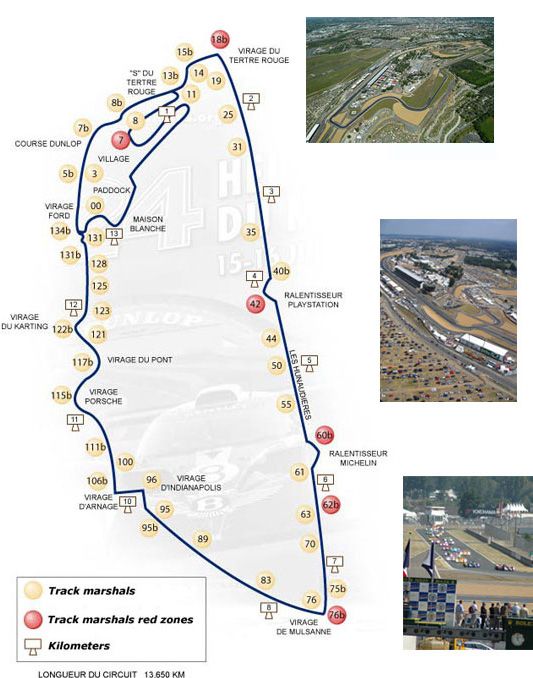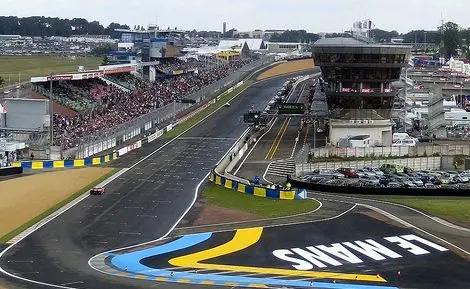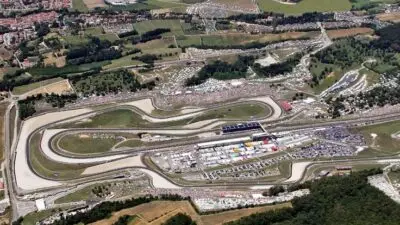The Circuit de la Sarthe in Le Mans, France stands as one of motorsport’s most iconic venues, combining public roads with purpose-built racing sections to create a legendary 8.5-mile course. This semi-permanent track has hosted the world-famous 24 Hours of Le Mans endurance race since 1923, making it the oldest automotive endurance race in the world. The circuit’s unique design allows regular traffic to use portions of the track throughout most of the year.

What makes Circuit de la Sarthe truly special is its blend of high-speed straights, technical corners, and rich racing history that spans over a century. The famous Mulsanne Straight stretches 4.2 miles, creating one of the longest flat-out sections in all of motorsport. Racing legends have battled here for decades, creating stories that define endurance racing.
From its distinctive track features to visitor experiences and deep motorsport heritage, Circuit de la Sarthe offers something for every racing enthusiast. The venue showcases how traditional road racing circuits can evolve while maintaining their authentic character and challenging nature.

Key Takeaways
- Circuit de la Sarthe combines public roads with racing sections to create a unique 8.5-mile semi-permanent motorsport venue in France.
- The track has hosted the legendary 24 Hours of Le Mans endurance race continuously since 1923, establishing its place in racing history.
- Visitors can experience both the main circuit and the shorter Bugatti Circuit while exploring one of motorsport’s most famous locations.
The Circuit de la Sarthe: Overview and Unique Characteristics

The Circuit de la Sarthe spans 13.626 kilometers and combines purpose-built racing sections with public roads that remain open to traffic throughout most of the year. This semi-permanent motorsport venue in Le Mans, France has undergone significant layout modifications since its creation in 1923.
Hybrid Track Design
The Circuit de la Sarthe features a rare hybrid design that sets it apart from traditional racing venues. The track combines private, race-specific sections with public roads that local residents use year-round.
Three distinct track types make up the circuit:
- Purpose-built racing sections with modern safety features
- Modified public roads temporarily closed during race events
- Pure public roads used by residents living within the circuit boundaries
This unique configuration creates challenges not found at permanent circuits. Drivers must adapt to varying surface conditions and road characteristics throughout a single lap.
The pit complex and main grandstand areas represent the permanent racing infrastructure. These sections feature modern amenities and safety equipment designed specifically for motorsport.
Location and Accessibility
The circuit sits in Le Mans, located in the Sarthe department of western France. The venue’s integration with public roads means portions remain accessible to regular traffic when racing events are not taking place.
Local residents navigate the same corners and straights that racing drivers use during competition weekends. This creates an unusual situation where the world’s most famous endurance racing circuit doubles as neighborhood streets.
The track’s location within an established community presents logistical challenges during major events. Temporary barriers and safety equipment must be installed and removed for each racing weekend.
Key accessibility features:
- Public road integration allows year-round local access
- Temporary closures during racing events
- Multiple access points throughout the circuit perimeter
Notable Layout Changes Over Time
The Circuit de la Sarthe has undergone significant modifications since its first use in 1923. Safety improvements and track updates have altered the original layout while maintaining its essential character.
Major chicanes were added to reduce speeds on the fastest sections. The Ford Chicane and other modifications broke up long straightaways where cars previously reached dangerous velocities.
The Bugatti Circuit represents a shorter permanent section that shares key elements with the full Le Mans layout. This includes the Ford Chicane, pit complex, and the straight featuring the Dunlop bridge.
Track surface improvements have replaced the original cobbled and dusty roads with modern asphalt. These changes maintain racing viability while preserving the circuit’s historic character and public road functionality.
Legendary Events and Racing Heritage

The Circuit de la Sarthe has hosted motorsport’s most prestigious endurance race since 1923, establishing itself as the ultimate proving ground for automotive manufacturers and drivers. The track’s unique blend of public roads and racing circuits has created legendary moments in Formula 1 history and cemented its status as France’s premier racing venue.
The 24 Hours of Le Mans
The 24 Hours of Le Mans stands as motorsport’s greatest endurance race, testing both man and machine over a full day and night cycle. Established in 1923, this legendary event transforms the Circuit de la Sarthe into racing’s most demanding battlefield.
The race attracts the world’s top manufacturers including Ferrari, Porsche, Audi, and Toyota. Each team fields three drivers who rotate throughout the 24-hour period, covering over 3,000 miles at average speeds exceeding 150 mph.
The 2025 race delivered another chapter of motorsport history when Ferrari’s #83 car claimed victory. The 93rd running of the event took place on June 14-15, 2025, continuing the race’s nearly century-long tradition.
Victory at Le Mans requires perfect strategy, flawless pit stops, and mechanical reliability. The race’s grueling nature eliminates half the field on average, making every finish an achievement.
Endurance Racing Legacy
The Circuit de la Sarthe hosts several prestigious endurance events beyond the famous 24-hour car race. The 24-hour motorcycle race pushes two-wheeled machines to their limits on the same legendary tarmac.
The track also features the 24-hour go-karting event and 24-hour truck race. These events showcase the circuit’s versatility while maintaining the endurance racing tradition that defines Le Mans.
Historic racing cars return during the Le Mans Classic, where over 750 classic vehicles represent different eras of racing history. This biennial event attracts more than 200,000 spectators who witness motorsport heritage come alive.
Legendary manufacturers like Bentley, Jaguar, Ford, and Matra have all written their names into Le Mans history. Their victories represent decades of automotive innovation and racing excellence.
Formula 1 and the French Grand Prix
The Circuit de la Sarthe hosted the French Grand Prix during Formula 1’s early decades, bringing the world’s premier racing series to Le Mans. The track’s unique layout challenged F1 drivers with its mix of high-speed straights and technical corners.
The French motorcycle Grand Prix continues this tradition, utilizing the circuit’s Bugatti configuration. This shorter layout maintains the challenging characteristics that made Le Mans famous in Formula 1.
The circuit’s 13.626-kilometer layout with 38 turns created memorable battles between racing legends. Drivers faced the same corners that would later become iconic during the 24 Hours of Le Mans.
While Formula 1 has moved to other French venues, the circuit’s Grand Prix heritage remains an important part of its racing DNA. The track’s ability to host both sprint races and endurance events demonstrates its exceptional design.
Famous Track Features and Sections

The Circuit de la Sarthe track contains several legendary sections that define the character of Le Mans racing. These iconic features test both driver skill and car reliability across the circuit’s 8.5-mile layout.
Mulsanne Straight
The Mulsanne Straight stands as the most famous section of the entire circuit. This long stretch of track allows cars to reach their maximum speeds during the race.
The straight originally measured over 3.7 miles without interruption. Cars could reach speeds exceeding 240 mph on this section during the 1980s.
Two chicanes were added in 1990 to reduce speeds for safety reasons. The chicanes split the straight into three shorter sections.
Modern race cars still reach impressive speeds between the chicanes. Top speeds now range from 200-220 mph depending on the car type.
The straight connects the Tertre Rouge corner to the Mulsanne corner. This section often determines race outcomes through slipstreaming battles.
Porsche Curves
The Porsche Curves form a challenging sequence of fast, sweeping turns. These corners require precise driving technique and brave commitment from drivers.
Located after the Indianapolis corner, the curves consist of two main bends. The first curve is a long right-hand sweeper that flows into a second right turn.
Cars maintain high speeds through this section, often exceeding 150 mph. The curves test a car’s aerodynamic balance and suspension setup.
Tire management becomes critical through these corners. The long, sustained loads can cause significant tire wear during the 24-hour race.
Many drivers consider the Porsche Curves among the most satisfying sections to drive. The flowing nature rewards smooth, committed driving styles.
Dunlop Chicane
The Dunlop Chicane creates one of the main overtaking opportunities on the circuit. This tight sequence follows the long Hunaudières section.
The chicane consists of a sharp left-right combination. Drivers must brake hard from high speeds to navigate the tight turns.
Heavy braking zones like this test brake durability during the endurance race. Teams must balance performance with component longevity.
Strategic positioning before the chicane often determines overtaking success. Drivers use slipstreaming to gain advantages into the braking zone.
The chicane leads onto another straight section toward Tertre Rouge. This creates additional opportunities for position changes.
Arnage Corner
Arnage represents the slowest corner on the entire circuit. This tight right-hand turn requires maximum braking and precise positioning.
Cars slow from high speeds to approximately 50 mph for this corner. The dramatic speed change puts enormous stress on braking systems.
Brake temperatures often reach critical levels at Arnage during races. Teams monitor these temperatures closely to prevent brake failure.
The corner features a slightly banked exit that helps with acceleration. Drivers must position their cars carefully to maximize exit speed.
Getting Arnage wrong can cost significant time on the following straight. The corner often separates experienced drivers from newcomers to the circuit.
The Bugatti Circuit: Inside Circuit de la Sarthe

The Bugatti circuit is a permanent race track located within Circuit des 24 Heures, named after Ettore Bugatti. This shorter configuration combines sections from the main Le Mans circuit with purpose-built racing infrastructure and has hosted major international racing events including Formula 1.
Design and Layout
The circuit uses a part of the larger circuit and a separate, purpose-built section. The track measures 4.185 kilometers in length and features 14 corners.
The sections of track on the Bugatti Circuit that are on the Circuit des 24 Heures include the Ford Chicane at the end of the lap, the pit complex, and the straight where the Dunlop Tyres bridge is located. These shared sections provide the same racing surface used during the famous 24 Hours of Le Mans.
The purpose-built sections were designed specifically for shorter race formats. These areas feature modern safety barriers and runoff areas that meet current racing standards.
The track layout creates a technical challenge with a mix of high-speed sections and tight corners. This combination tests both driver skill and car setup across different racing disciplines.
Key Motorsport Events
The Bugatti Circuit hosted the 1967 F1 French Grand Prix and won by three time Australian world champion Jack Brabham. This remains one of the most significant Formula 1 races held at the facility.
The track regularly hosts the French Motorcycle Grand Prix as part of the MotoGP World Championship. This event brings thousands of motorcycle racing fans to Le Mans each year.
Various national and international racing series use the Bugatti Circuit throughout the racing season. These events include touring car championships, motorcycle racing, and driver training programs.
The shorter layout makes it ideal for events that require multiple sessions per day. Race organizers can run different categories without the extended lap times of the full Circuit de la Sarthe.
Visitor Experience and Travel Tips

Planning a visit to Circuit de la Sarthe requires careful preparation for transportation, lodging, and navigating the massive venue during race events. The track’s location south of Le Mans city and its temporary road closures during events create unique challenges for visitors.
Getting to Le Mans
Le Mans sits about 200 kilometers southwest of Paris. The city connects to major French highways through the A11 autoroute.
Visitors can reach Le Mans by train from Paris Montparnasse station. The journey takes approximately one hour on direct TGV services. Regular trains also run throughout the day.
By Car:
- A11 autoroute from Paris (2 hours)
- A28 from Normandy and Calais
- Expect heavy traffic during race weekends
The nearest airport is Le Mans-Arnage, which handles private aircraft during events. Most international visitors fly into Paris Charles de Gaulle and travel by train or rental car.
Circuit de la Sarthe sits south of the city on the road to Tours. Local buses run from the city center to the circuit during major events.
Accommodation Options
Le Mans offers limited hotel capacity during the 24 Hours race weekend. Booking accommodations 6-12 months in advance prevents disappointment.
Hotel Categories:
- City Center Hotels: Walking distance to restaurants and train station
- Circuit-Area Hotels: Closer to track but fewer dining options
- Budget Options: Hostels and budget chains on city outskirts
Many visitors stay in nearby towns like Tours, Angers, or even Paris. These locations require longer travel times but offer more availability.
Camping remains popular during race weekends. Official campsites operate near the circuit with basic facilities. Private landowners also rent camping space to visitors.
Vacation rentals work well for groups. Properties in Le Mans and surrounding villages fill quickly during race season.
Navigating the Circuit During Events
Circuit de la Sarthe spans 13.6 kilometers with multiple viewing areas and facilities. The circuit combines permanent track sections with public roads that close temporarily during events.
Main Viewing Areas:
- Grandstands: Reserved seating with better views
- General Admission: Access to multiple trackside locations
- Mulsanne Corner: Popular free viewing spot
The venue operates shuttle buses between different circuit sections during major events. Walking the entire circuit perimeter takes several hours.
Food vendors and merchandise stands cluster near main entrances and popular viewing areas. Prices increase significantly during race weekends.
Essential Items:
- Comfortable walking shoes
- Weather protection (rain gear/sun hat)
- Ear protection for loud racing events
- Cash for vendors and parking
Parking fills quickly on race days. Arriving early or using park-and-ride services from the city center works better than driving directly to the circuit.
Circuit de la Sarthe in Motorsport History

The Circuit de la Sarthe has witnessed automotive rivalries and technological advancements that shaped endurance racing. The track became the testing ground for innovations that changed how cars are built and raced around the world.
Milestone Moments
The circuit opened in 1923 when organizers combined existing public roads with a race track. This created the foundation for what would become motorsport’s most famous endurance race.
Ford vs Ferrari battles dominated the 1960s at Circuit de la Sarthe. American manufacturers challenged European dominance in a rivalry that captured global attention. These races proved that endurance racing could showcase both speed and reliability.
The Great Depression and World War II interrupted racing at the circuit. However, the track resumed operations and continued growing in importance. Post-war racing brought new manufacturers and technologies to Le Mans.
Audi’s dominance marked the 21st century at Circuit de la Sarthe. The German manufacturer won multiple races and pushed hybrid technology forward. Their success showed how endurance racing drives innovation.
The circuit’s 4.2-mile Mulsanne Straight became legendary for high-speed battles. This section tested both driver courage and car engineering limits.
Influence on Racing Innovation
Circuit de la Sarthe became a proving ground for automotive technology. Manufacturers used the endurance race to test new engines, materials, and safety systems. Innovations developed here often appeared in road cars later.
Aerodynamic advances emerged from racing at the circuit. Teams developed better downforce systems and drag reduction techniques. These improvements helped cars handle the circuit’s mix of high-speed straights and tight corners.
Hybrid powertrains found their motorsport home at Circuit de la Sarthe. Toyota, Audi, and Porsche all developed advanced hybrid systems for endurance racing. This technology transfer helped accelerate hybrid adoption in consumer vehicles.
Safety innovations grew from accidents and near-misses at the circuit. Better crash barriers, improved helmet designs, and stronger car structures all developed through endurance racing. The circuit’s combination of public roads and permanent sections created unique safety challenges.
The track influenced tire development significantly. The long race distance and varied surface conditions pushed tire manufacturers to create better compounds and construction methods.
Frequently Asked Questions

The Circuit de la Sarthe hosts the world’s most famous endurance race and attracts thousands of motorsport fans each year. Visitors need specific information about ticketing, track specifications, safety protocols, and the circuit’s rich racing history.
What are the most notable historical moments at Circuit de la Sarthe?
The Circuit de la Sarthe has witnessed countless memorable moments since its first race. The track gained worldwide recognition as the venue for the 24 Hours of Le Mans auto race.
One of the most significant changes occurred on the Mulsanne Straight. The legendary stretch was once a flat-out, three-mile-long sprint where cars reached staggering speeds. Safety concerns led to the addition of chicanes to break up the straight.
The circuit has also expanded beyond endurance racing. It now hosts the MotoGP Grand Prix de France alongside its traditional automotive events.
How can spectators purchase tickets for events at Circuit de la Sarthe?
Spectators can find ticket information and accommodation details through official motorsport tourism resources. The circuit offers various ticket packages for different events throughout the racing season.
General admission and premium seating options are available for major events. Advance booking is recommended due to high demand for popular races like the 24 Hours of Le Mans.
What is the complete schedule of races for Circuit de la Sarthe this season?
The circuit’s race calendar includes multiple motorsport disciplines throughout the year. The 24 Hours of Le Mans remains the most famous endurance race hosted at the facility.
MotoGP events are also part of the annual schedule. The circuit hosts both automotive and motorcycle racing events for international competition.
What is the official track length of Circuit de la Sarthe, and how does it compare to other world circuits?
The Circuit de la Sarthe is one of the longest permanent racing circuits in the world. The track combines purpose-built racing sections with public roads to create its unique layout.
The circuit’s length makes it distinctive among international racing venues. Most Formula 1 circuits are significantly shorter than the Le Mans configuration used for endurance racing.
Can you detail the different track configurations used during the Le Mans 24 Hours race?
The Circuit de la Sarthe is a semi-permanent motorsport race course that uses both dedicated racing sections and public roads. The track includes private sections designed specifically for racing and public roads that run year-round for local use.
The Le Mans 24 Hours uses the full circuit configuration. This layout includes the famous Mulsanne Straight and various technical sections that test both speed and handling.
Different racing series may use modified versions of the track. The configuration can be adjusted based on the specific requirements of each motorsport event.
What security and safety measures are implemented during events at Circuit de la Sarthe?
The circuit implements comprehensive safety protocols for all racing events. Modern safety barriers and run-off areas have been installed throughout the track to protect drivers and spectators.
Emergency response teams are stationed around the circuit during events. Medical facilities and fire safety equipment are positioned at strategic locations along the track.
Spectator areas include proper barriers and designated viewing zones. The circuit management works with local authorities to ensure crowd control and emergency access routes remain clear during events.



